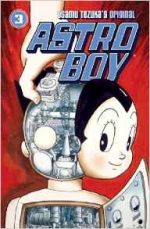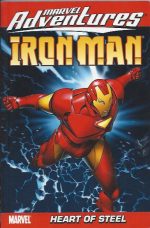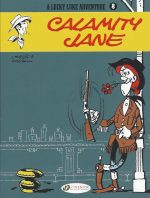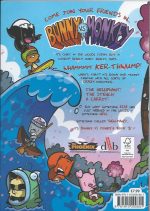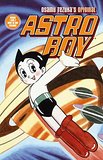
By Osamu Tezuka, translated by Frederik L. Schodt (Dark Horse Manga)
ISBN: 978-1-59582-153-9
There aren’t many Names in comics.
Lots of creators; multi-disciplined or single-focussed, who have contributed to the body of the art form, but precious few Global Presences whose contributions have affected generations of readers and aspirants all over the World, like a Mozart, Michelangelo or Shakespeare.
We only have Hergé, Jack Kirby, Moebius, Will Eisner and Osamu Tezuka.
Tezuka rescued and revolutionised the Japanese comics industry. Beginning in the late 1940s, he generated an incomprehensible volume of quality work that transformed the world of manga and how it was perceived. A passionate fan of Walt Disney’s cartoon films, he performed similar sterling service with the country’s fledgling animation industry.
His earliest stories were intended for children but right from the start his ambitious, expansive fairytale-flavoured stylisations harboured more mature themes and held hidden treasures for older readers and the legion of fans who would grow up with his many manga masterpieces…
“The God of Comics†was born in Osaka Prefecture on November 3rd 1928. As a child he suffered from a severe illness which made his arms swell. The doctor who cured him also inspired the boy to study medicine, and although Osamu began his professional drawing career while at university in 1946, he wisely persevered with his studies and qualified as a medical practitioner too. Then, as he faced a career crossroads, his mother advised him to do the thing which made him happiest.
He never practiced as a healer but the world was gifted with such unforgettable comics masterpieces as Kimba the White Lion, Buddha, Adolf, Black Jack and so many other graphic narratives.
Working ceaselessly over decades Tezuka and his creations inevitably matured, but he was always able to speak to the hearts and minds of children and adults equally. His creations ranged from the childishly charming to the disturbing – and even terrifying such as Ningen Konchuuki which we’ve seen in the West as The Book of Human Insects.
He died on February 9th 1989: having written and drawn more than 150,000 pages of comics, recreated the Japanese anime industry and popularised a peculiarly Japanese iteration of graphic narrative and made it a part of world culture.
This superb digest (168 x 109 x 33 mm) paperback gathers two earlier volumes in one massive monochrome compilation; presenting in non-linear order some early exploits of his signature character, with the emphasis firmly on fantastic fun and family entertainment…
Tetsuwan Atomu (literally “Mighty Atom†but known universally as Astro Boy due to its successful, if bowdlerised, dissemination around the world as an animated TV cartoon) is a spectacular, riotous, rollicking sci fi action-adventure starring a young boy who also happens to be one of the mightiest robots on Earth.
The iconic series began in the April 3rd 1952 issue of ShÅnen Kobunsha and ran intermittently until March 12th 1968 – although he often returned to add to the canon in later years. Over that time Astro spawned the aforementioned groundbreaking TV cartoon, comics specials, games, toys, collectibles, movies and the undying devotion of generations of ardent fans.
Tezuka often drew himself into his tales as a commentator and here in his revisions and introductions mentions how often he found the restrictions of ShÅnen comics stifling; specifically, perpetually pausing the plot to placate the demands of his audience by providing a blockbusting fight every episode.
As further explained in the context-expanding and defining Introduction by scholar and series translator Frederik L. Schodt, Tezuka and his production team were never as wedded to close continuity as fans: constantly tinkering and revising both stories and artwork in later collections. It’s the reason this series seems to skip up and down the publishing chronology. The intent is to entertain at all times so the stories aren’t treated as gospel and their order immutable or inviolate…
There’s a final prevarication in ‘A Note to Readers’ explaining why one thing that hasn’t been altered is the depictions of various racial types in the stories before the cartoon wonders commence with ‘The Birth of Astro Boy’. This was first seen in June 20th 1975 as part of a new story for volume 1 of Asahi Sonorama’s Tetsuwan Atomu reprint series.
In the early days origins were never as important as getting on with having adventures, but here the secret is exposed as the development of a world where robots are ubiquitous and have (sometimes limited) human rights is described in detail, as are the laws of robotics which govern them.
When brilliant Dr. Tenma lost his son Tobio in a road accident, the grief-stricken genius used his position as head of Japan’s Ministry of Science to build a replacement. The android his team created was one of the most ground-breaking constructions in history, and for a while Tenma was content. However, as his mind stabilised, Tenma realised the unchanging humanoid was not Tobio and with cruel clarity rejected the replacement. He ultimately removed the insult to his real boy by selling the robot to a shady dealer…
Some time later, independent researcher Professor Ochanomizu was in the audience at a robot circus and realised the little performer “Astro†was unlike the other acts – or any construction he had ever encountered…
He convinced the circus owners to part with the little bot and, after studying the unique boy, realised just what a miracle had come into his hands…
Introductions over, the vintage tales properly begin with a rather disturbing adventure as ‘The Hot Dog Corps’ (ShÅnen Kobunsha March to October 1961) pits the solenoid superhero against a maniac stealing pets. After much investigation our champions discover with horror that mystery villains were implanting canine nervous systems in humanoid warrior bodies to circumvent the Laws preventing robots from fighting humans…
Part of Ochanomizu’s socialization process for Astro included placing him in a family environment and having him attend school just like a real boy, and the metal and plastic marvel became embroiled in the bizarre interplanetary plot when his Elementary School teacher Higeoyaji (AKA Mr. Mustachio) had his beloved dog stolen by Cossacks in a flying car…
After many false leads and deadly battles all over the world, the trail finally leads the valiant robot to a hidden polar base and an ancient city on the Moon, where a deranged Russian émigré plans a deadly revenge on the world that abandoned her…
Thankfully with Earth under overwhelming assault, mighty Astro Boy finds that a dog’s love for his master transcends shape and he has a secret ally deep within the enemy’s ranks…
Although a series built on spectacular action sequences and bombastic battles, Astro Boy had a skilful way of tugging heartstrings and hitting hard with the slapstick.
‘Plant People’ was a short tale from 1961’s Special Expanded New Years Day Edition of ShÅnen which opens with Astro and his school chums playing in the snow. At the height of their sport they accidentally uncover a strange alien flower. Engaging his friends’ rapt attention, the Plastic Pinocchio then describes how he foiled an alien invasion in this location and how a valiant extraterrestrial ally perished on that very spot, only to be transformed into…
Following a leisurely and scathing discussion of violence in his comics and the squeamishness of America’s TX executives over content in the TV episodes, cartoon Tezuka yields focus to Astro Boy for ‘His Highness Deadcross’ (September through December 1960 in ShÅnen magazine).
Here the super-synthezoid answers a surreal plea from an embattled leader desperate to save his nation. President Rag rules in the first nation to elect a robot to high office, but although voted in by both an organic and mechanical electorate, the robot ruler is being undermined and targeted for destruction by a sinister cabal he is unable to act against because of his core programming to never harm humans.
Astro is similarly restricted, but he also has a super brain and might be able to find a solution to this dreadful crisis…
Panicked yet emboldened, Deadcross craftily imprisons Mustachio for a little leverage whilst launching an all-out assault with deadly mindless mechanical monsters. Astro valiantly overcomes the invaders, but the mastermind then plays his trump card and replaces President Rag with a subservient substitute…
To make matters worse, Astro – depleted of energy after saving Mustachio – is reduced to fragments by Deadcross’ marauders, and with the nation about to fall to the usurpers, the liberated teacher and recently-arrived Professor Ochanomizu strive mightily to rebuild their robotic redeemer in time to expose the plot and save the day…
‘The Third Magician’ originally appeared in ShÅnen between October 1961 and January 1962 and sees Kino, the world’s greatest stage illusionist, captured by another proponent of the art of prestidigitation. That villain calls himself Noh Uno and wants the secret of passing through walls, even if he has to dismantle the presumptuous, uppity robot conjuror to get it…
Like most kids, Astro is a huge fan of Kino and when his super-hearing picks up the magician’s distress he charges to the rescue. Tragically, by the time he battles through Noh Uno’s house of horrors he is too late…
A few days later Japan is shocked by an announcement that the amazing Kino is going to steal one hundred priceless works of art in one go. The police are unwilling to listen to Astro or Mustachio’s protestations that Noh Uno is the real culprit and their diligent preparations only make the heist easier for the villain…
A confrontation between Inspector Tawashi and Kino only convinces the authorities they are correct. It also leads the powers that be to start the legislative process to pre-emptively lobotomise all high functioning robots…
With so much at stake Astro Boy ignores official orders. Undertaking more intensive investigation and amidst increasing political unrest, he tracks down Kino, only to discover that the seemingly-corrupt conjuror has a double possessing all his gifts and tricks.
On the run from the cops, Astro and Kino persevere and lead their pursuers a merry chase which leads to the subterranean lair of Noh Ino and the Third Magician. Now all they have to do is defeat them, clear their names and stop the anti-robot bill…
This initial exploration of a classic cartoon future concludes with a delightful homage to another trans-Pacific antique anime export. ‘White Planet’ came from the New Years 1963 edition of ShÅnen and featured a tribute to the early manga works of Tatsuo Yoshida whose Mach GoGoGo and its seminal progenitor Pilot Ace would become another American Anime hit in the 1960s: Speed Racer…
In this smart pastiche, Astro aids a boy racer whose intelligent super-car is sabotaged just prior to a round-the-world grand prix. Astro and Ochanomizu have a robotic solution to his dilemma, but it will take a tragic sacrifice to make it work…
Wrapping things up is a potted biography of ‘Osama Tezuka’: making this a perfect introduction to the mastery of a man who reinvented popular culture in Japan and who can still deliver a powerful punch and wide-eyed wonder on a variety of intellectual levels.
Astro Boy is one of the most beguiling kids’ comics ever crafted: a work that all fans and parents should know, but be warned, although tastefully executed, these tales don’t sugar-coat drama or action and not all endings can be truly judged as happy.
The material in this tome plus volume 3 were combined and re-released in 2015 as the first wrist-wrenching, eye-straining Astro Boy Omnibus, but you can avoid injury and ongoing controversy about whether that tome is too small and heavy to read (I admit I found it so) by picking up this splendid, physically accessible and still readily available edition from your preferred internet vendor or online comics service… and you really, really should…
Tetsuwan Atom by Osama Tezuka © 2002, 2008 by Tezuka Productions. All rights reserved. Unedited translation and Introduction © 2002 Frederik L. Schodt.





